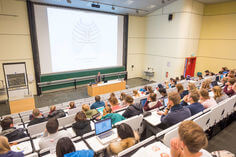1. Name: Thomas Kuner, MD
Address: Department of Functional Neuroanatomy
Institute for Anatomy and Cell Biology
Medical Faculty Heidelberg, Heidelberg University
Im Neuenheimer Feld 307, 69120 Heidelberg
Tel.: +49-6221-548678, Fax: +49-6221-544951
E-mail: kuner(at)uni-heidelberg.de
Current position: Professor, Director, Dept. of Functional Neuroanatomy
2. Education
09/2003 Habilitation in Physiology, University of Heidelberg (Prof. Dr. B. Sakmann)
06/1998 Dr. med., Summa cum l., University of Heidelberg (Prof. Dr. P. H. Seeburg)
07/1992 – 03/1997 Doctoral thesis at the Center for Molecular Biology Heidelberg
04/1988 – 03/1998 Study of Medicine at the University of Heidelberg
3. Academic positions
08/2012- Director, Department of Functional Neuroanatomy, Heidelberg University
08/2006 – 07/2012 Professor at the Department of Medical Cell Biology, Heidelberg University
10/2000 – 07/2006 Group leader, Max Planck Institute for Medical Research, Heidelberg
08/1998 – 09/2000 Postdoctoral fellow, Duke University Medical Center, Durham, and
Marine Biological Laboratory, Woods Hole, (Prof. George J. Augustine), USA.
4. Research interests
Molecular mechanisms of synaptic transmission, structure and function of presynaptic nerve terminals, experience-dependent structural plasticity, sensory physiology, molecular and cellular mechanisms of odor discrimination, central mechanisms of pain, thalamocortical communication, neuronal ensembles, chloride homeostasis and neuronal function, translational research linking basic science to medicine (neuron-glioma communication, schizophrenia), genetically encoded indicators, imaging techniques (superresolution, electron microscopy, in vivo 2 photon and endoscopic imaging).
5. Miscellaneous
Memberships, panels and editorial functions
Societies: Anatomische Gesellschaft (AG), Deutsche Physiologische Gesellschaft (DPG), Neurowissenschaftliche Gesellschaft (NWG), International Association for the Study of Pain (IASP).
Journals: Pflügers Archiv European Journal of Physiology (Deputy Executive Editor 2004-2007) Frontiers in Molecular Neuroscience (Reviewing Editor 2008-2014; Associate Editor 2015-)
Panels: Speaker of the WIN-Kolleg of the Heidelberg Academy of Sciences (2003-2006).
Stipends
1989 – 1994 Fellowship by the German National Fellowship Foundation
1998 – 1999 Feodor-Lynen Fellow of the Alexander von Humboldt Foundation
1999 – 2000 Human Frontiers in Science Program Long-Term Fellowship
2000 Grass Fellowship in Neurosciences
2000 – 2003 Habilitation Fellowship of the Claussen-Simon Foundation
Honors and Awards
2003 – 2006 WIN-Kollegiat of the Heidelberg Academy of Sciences
2012/13 Fellow of the Marsilius Kolleg for Interdisciplinary Studies at Heidelberg University
2014 Heidelberg University Annual Price for Exceptional Achievements
6. Grant support (since 2010)
DFG research grant “Contribution of ionotropic glutamate receptors to olfactory processing” (SPP 1392, 2009-2013)
GIF grant “Organization of active zones” (2008-2011).
Royal Society eGAP grant “Ultrastructure of active zones” (2009-2011)
EU Initial training network “BrainTrain” (2009-2013)
DFG SFB 636 “Mechanisms underlying structural plasticity during memory consolidation in forebrain circuits” (2012-2016)
DFG SPP 1392, second funding period, “Mechanism of inhibitory processing in olfactory discrimination behavior” (2012-2015)
National Science Foundation (USA) - Germany Computational Neuroscience Grant IOS-1208029, “The effects of chloride dynamics in cerebellar computation”, (2012-2015)
DFG SFB 1134 "Functional Ensembles", TP A4 and TP B4
DFG SFB 1158 "From nociception to chronic pain", TP8
HeiKA Bridge Grant (2019) "Novel Zeolite Sensors"
BW Foundation “Internationale Spitzenwissenschaften” (2020-2022)
BW Foundation Methods in Life Sciences “Mult!Nano” (2020-2022)
DFG Grant Ku1983/8 “Corticothalamic ensemles for multimodal salience coding”
7. Selected publications
Glutamate receptor structure and function
Kuner T#, Wollmuth LP, Karlin A, Seeburg PH, Sakmann B. (1996). Structure of the NMDA receptor channel M2 segment inferred from the accessibility of substituted cysteines. Neuron 17: 343-352.
Beck C, Wollmuth LP, Seeburg PH, Sakmann B, Kuner T# (1999). NMDA receptor channel segments forming the extracellular vestibule inferred from the accessbility of substituted cysteines. Neuron 22, 559-570.
Kuner T#, Beck, C., Sakmann, B., Seeburg, P. H. (2001). Channel-lining residues of the AMPA receptor M2 segment: structural environment of the Q/R site and identification of the selectivity filter. J. Neuroscience 21:4162-4172.
Chloride physiology
Dübel J, Haverkamp S, Schleich W, Augustine GJ, Feng G, Kuner T#, Euler T# (2006). Two-photon imaging reveals somato-dendritic chloride gradient in retinal ON-type bipolar cells expressing the biosensor Clomeleon. Neuron 49: 81-49.
Mohapatra, N., Tønnesen, J., Vlachos, A., Kuner, T., Deller, T., Nägerl, V.U., Santamaria, F. and Jedlicka, P. (2016). Spines slow down dendritic chloride diffusion and affect short-term ionic plasticity of GABAergic inhibition. Scientific Reports 6:23196.
Boffi, JC, Knabbe J, Kaiser M, Kuner T (2018). KCC2-dependent Steady-state Intracellular Chloride Concentration and pH in Cortical Layer 2/3 Neurons of Anesthetized and Awake Mice. Front Cell Neurosci. 2018 Jan 25;12:7. doi: 10.3389/fncel.2018.00007.
Olfaction
Abraham NM, Egger V, Shimshek DR, Renden R, Fukunaga I, Sprengel R, Seeburg PH, Klugmann M, Margrie TW, Schaefer AT, Kuner T (2010) Synaptic inhibition in the olfactory bulb accelerates odor discrimination in mice. Neuron 65: 399-411.
Nunes, D. and Kuner, T. (2015). Disinhibition of olfactory bulb granule cells accelerates odor discrimination in mice. Nature Communications 6:8950.
Nunes, D. and Kuner, T. (2018). Axonal sodium channel NaV1.2 drives granule cell dendritic GABA release and rapid odor discrimination. PLoS Biology, 16(8):e2003816.
Pain
Luo C, Gangadharan V, Bali K, Xie RG, Agarwal N, Kurejova M, Tappe-Theodor A, Tegeder I, Feil S, Lewin G, Polgar E, Todd AJ, Schlossmann J, Hofmann F, Liu DL, Hu SJ, Feil R, Kuner T, Kuner R (2012). Presynaptically Localized Cyclic GMP-Dependent Protein Kinase 1 Is a Key Determinant of Spinal Synaptic Potentiation and Pain Hypersensitivity. PLoS Biol 10(3): e1001283. doi:10.1371/journal.pbio.1001283.
Gangadharan, V., Selvaraj, D., Kurejova, M., Njoo, C., Gritsch, S., Škoricová, D., Horstmann, H., Offermanns, S., Brown, A.J., Kuner, T., Tappe-Theodor, A. and Kuner, R. (2013). A novel biological role for the phospholipid lysophosphatidylinositol in nociceptive sensitization via activation of diverse G-protein signalling pathways in sensory nerves in vivo., Pain 154(12), 2801–2812.
Tan LL, Pelzer P, Heinl C, Tang W, Gangadharan V, Flor H, Sprengel R, Kuner T, Kuner R. (2017). A pathway from midcingulate cortex to posterior insula gates nociceptive hypersensitivity. Nat Neurosci, doi: 10.1038/nn.4645.
Neocortical and thalamic physiology
Seol, M. and Kuner, T. (2015). Ionotropic glutamate receptor GluA4 and T-type calcium channel Cav3.1 subunits control key aspects of synaptic transmission at the mouse L5B-POm giant synapse. European Journal of Neuroscience 42, 3033-3044.
Pelzer, P., Horstmann, H., Kuner, T. (2017). Ultrastructural and Functional Properties of a Giant Synapse Driving the Piriform Cortex to Mediodorsal Thalamus Projection. Frontiers in Synaptic Neuroscience 9:3, doi.org/10.3389/fnsyn.2017.00003.
Mease RA, Kuner T, Fairhall AL, Groh A (2017). Multiplexed Spike Coding and Adaptation in the Thalamus. Cell Rep, 2017 vol. 19 (6) pp. 1130-1140.
Presynaptic structure and function
Kuner T, Li Y, Gee KR, Bonewald LF, Augustine GJ (2008). Photolysis of a caged peptide reveals rapid action of N-ethylmaleimide sensitive factor before neurotransmitter release. PNAS 108: 347-352.
Vasileva M, Horstmann H, Geumann C, Gitler D, Kuner T (2012). Synapsin-dependent reserve pool of synaptic vesicles supports replenishment of the readily releasable pool under intense synaptic transmission. European Journal of Neuroscience, 36:3005-3020.
Körber C, Horstmann H, Sätzler K, Kuner T (2012). Endocytic structures and synaptic vesicle recycling at a central synapse in awake rats. Traffic, 13:1601-11.
Körber, C., Dondzillo, A., Eisenhardt, G., Herrmannsdörfer, F., Wafzig, O., & Kuner, T. (2014). Gene expression profile during functional maturation of a central mammalian synapse. European Journal of Neuroscience 13:1601-11.
Körber, C., Horstmann, H., Venkataramani, V., Herrmannsdörfer, F., Kremer, T., Kaiser, M., Schwenger, D.B., Ahmed, S. Dean, C. Dresbach, T. & Kuner, T. (2015). Modulation of presynaptic release probability by the vertebrate-specific protein mover. Neuron, 87:521-533.
Methods development
Kuner T, Augustine GJ (2000) A genetically encoded ratiometric indicator for chloride: capturing chloride transients in hippocampal neurons. Neuron 27: 447-459.
Wimmer VC, Nevian T, Kuner T (2004). Targeted in vivo expression of proteins in the calyx of Held. Pflugers Archiv/European Journal of Physiology 449, 319-333.
Horstmann H, Körber C, Sätzler K, Aydin D, Kuner T (2012). Serial Section Scanning Electron Microscopy (S3EM) on Silicon Wafers for Ultrastructural Volume Imaging of Cells and Tissues. PLoS One 7(4): e35172. doi:10.1371/journal.pone.0035172.
Nanguneri S, Flottmann B, Horstmann H, Heilemann M, Kuner T (2012). Three-dimensional, tomographic super-resolution fluorescence imaging of serially sectioned thick samples. PloS one, 7(5), e38098. doi:10.1371/journal.pone.0038098.
Venkataramani, V., Herrmannsdörfer, F., Heilemann, M., Kuner, T. (2016). SuReSim – Simulating localization microscopy experiments from ground truth models. Nature Methods 13:319-21.
Knabbe J, Nassal JP, Verhage M, Kuner T (2018). Secretory vesicle trafficking in awake and anaesthetized mice: differential speeds in axons versus synapses. J Physiol. 2018 Jun 6. doi: 10.1113/JP276022.
Translational research linking basic science to medicine - neurooncology
Osswald M, Jung E, Sahm F, Solecki G, Venkataramani V, Blaes J, Weil S, Horstmann H, Wiestler B, Syed M, Huang L, Ratliff M, Karimian Jazi K, Kurz FT, Schmenger T, Lemke D, Gömmel M, Pauli M, Liao Y, Häring P, Pusch S, Herl V, Steinhäuser C, Krunic D, Jarahian M, Miletic H, Berghoff AS, Griesbeck O, Kalamakis G, Garaschuk O, Preusser M, Weiss S, Liu H, Heiland S, Platten M, Huber PE, Kuner T, von Deimling A, Wick W, Winkler F. (2015). Brain tumour cells interconnect to a functional and resistant network. Nature 528:93-98.
Venkataramani, V., Tanev, D., Strahle, C., Studier-Fischer, A., Fankhauser, L., Kessler, T., Körber, C., Kardorff, M., Ratliff, M., Xie, R., Horstmann, H., Messer, M., Paik, S., Knabbe, J., Sahm, F., Kurz, F., Acikgöz, A., Herrmannsdörfer, F., Agarwal, A., Bergles, D., Chalmers, A., Miletic, H., Turcan, S., Mawrin, C., Hänggi, D., Liu, H., Wick, W., Winkler, F.*, Kuner, T*. (2019). Glutamatergic synaptic input to glioma cells drives brain tumour progression. Nature 573, 532-538.



